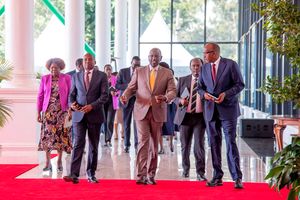Premium
Kenyans should now watch out for exposure to debt vulnerabilities

Kenya's debt crisis has been cooking since the Jubilee administration took charge.
What you need to know:
- Kenya’s public debt rose from 48 per cent of GDP in 2014 to 66 per cent in 2019 and is expected to reach 70 per cent in 2022.
- Debt payments have also increased rapidly owing to large fiscal deficits driven by the revenue shortfalls, large infrastructure investments and a ballooning wage bill.
Kenya has been contracting debt at an alarming rate, borrowing about Sh56 billion per month or Sh1.8 billion per day between 2014 and 2020.
Simply put, the amount of debt accumulation per month is enough to build another Thika Superhighway, two Kenyatta University Teaching, Referral and Research Hospitals, buy personal protective equipment (PPE) kits and KN95 face masks for two million health workers – and keep some change.
Kenya’s public debt grew from Sh2.4 trillion in 2014 to Sh7.1 trillion or 196 per cent as of September 2020 while revenue grew from 1 trillion to Sh1.6 trillion or 52 per cent in the same period.
In the current financial year (2020/2021) alone, the country will borrow Sh1 trillion and spend Sh900 billion on debt repayment. Public debt service expenses are projected to hit 1 trillion next year, putting excess pressure on the declining revenue performance due to Covid-19 challenges.
Economic recovery
This has put the country between a rock and a hard place – torn between borrowing again for much-needed spending on health, social protection and economic recovery and containing debt at sustainable levels.
Kenya’s public debt rose from 48 per cent of GDP in 2014 to 66 per cent in 2019 and is expected to reach 70 per cent in 2022.
Debt payments have also increased rapidly owing to large fiscal deficits driven by the revenue shortfalls, large infrastructure investments and a ballooning wage bill. In May this year, the International Monetary Fund (IMF) raised Kenya's risk of debt distress from moderate to high.
High risk of debt distress means that a country is likely to default or face difficulties in servicing debt while meeting its strategic policy objectives such as the Big Four Agenda, Post-Covid-19 Economic Recovery Strategy and the referendum.
Other countries in the region at high risk of debt distress include Zambia, Ethiopia and Burundi. Zimbabwe, Sudan and Mozambique are already in debt distress while Rwanda and Uganda are in moderate and low risk debt distress, respectively.
Liquidity challenges
Five months ago, Kenya rejected the G20’s Debt Service Suspension Initiative (DSSI) offer; an arrangement where bilateral lenders agreed to suspend debt service for external debt for low and middle-income countries facing liquidity challenges due to the pandemic.
The National Treasury described the DSSI terms as restrictive as they would result in defaulting on private loans, which would limit access to future credit markets elsewhere.
However, the recent move by the National Treasury to defer payment of interest worth Sh73 billion on government securities held by pension funds and insurance companies and the decision to return to Pre-Covid-19 taxes on Value Added Tax (VAT) points to difficult times ahead.
The Kenya public finance management laws provide that the government should match its recurrent expenditure with its revenues and only borrow for development. However, the current revenue is not enough to cater for recurrent expenditure.
In the financial year 2020/21, the Kenya Revenue Authority (KRA) expects to collect Sh1.6 trillion from taxes.
This is not enough to cover debt service at Sh900 billion, pay salaries and wages of Sh570 billion to national government employees and meet Sh383 billion for equitable share to the counties before thinking of more debt for development calculated at Sh355 billion.
Given the government’s failure to bring the budget deficit under control in past years, there is reason to question whether it will resist more debt uptake.
Further domestic borrowing, which is estimated at Sh786 billion in the current financial year, is likely to limit household and local firms’ access to the capital needed for their investment.
On the other hand, excessive external borrowing is likely to expose the country to currency risks, debt repayment and creditworthiness challenges. To avoid such unprecedented occurrences, the government should curtail all non-essential spending.
This will create space for pandemic-related spending and economic recovery. In addition, the government needs to urgently deepen governance, anti-corruption and Public Finance Management (PFM) reforms to guarantee transparency, accountability, citizen involvement and efficiency.





